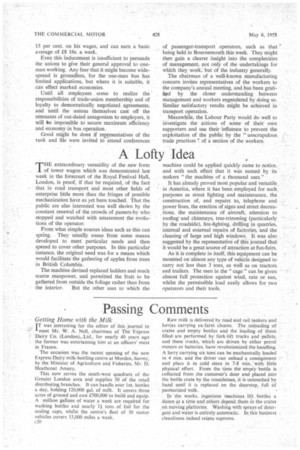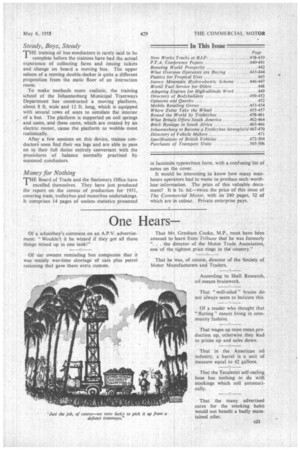Passing Comments
Page 70

Page 71

If you've noticed an error in this article please click here to report it so we can fix it.
Getting Home with the Milk
I T was interesting for the editor of this journal to meet Mr. W. A. Nell, chairman of The Express Dairy Co. (London),.Ltd., for nearly 40 years ago the former was entertaining him at an officers' mess in France.
The occasion was the recent opening of the new Express Dairy milk-bottling centre at Morden, Surrey, by the Minister of Agriculture and Fisheries, Mr. D. Heathcoat Amory.
This now serves the south-west quadrant of the Greater London area and supplies 50 of the retail distributing branches. It can handle over 1m. bottles a day, holding 120,000 gal. of milk. It covers three acres of ground and cost £700,000 to build and equip. A million gallons of water a week are required for washing bottles and nearly l tons of foil for the sealing caps, whilst the centre's fleet of 30 motor vehicles covers 15,000 miles a week.
c20 Raw milk is delivered by road and rail tankers and lorries carrying ex-farm churns. The unloading of crates and empty bottles and the loading of those filledare performed by fork-lift trucks and pallets, and these trucks, which are driven by either petrol motors or batteries, have revolutionized the handling. A lorry carrying six tons can be mechanically loaded in 4 min. and the driver can unload a consignment and place it in cold store in 7-8 min. with little physical effort. From the time the empty bottle is collected from the customer's door and placed into the bottle crate by the roundsman, it is untouched by hand until it is replaced on the doorstep, full of pasteurized milk.
In the works, ingenious machines lift bottles a dozen at a time and others deposit them in the crates on moving platforms. Washing with sprays of detergent and water is entirely automatic. In this business cleanliness indeed reigns supreme.
Steady, Boys, Steady
THE training of bus conductors is rarely said to be
complete before the trainees have had the actual experience of collecting fares and issuing tickets and change on board a moving bus. The upper saloon of a moving double-decker is quite a different proposition from the static floor of an instruction room.
To make methods more realistic, the training school of the Johannesburg Municipal Tramways Department has constructed a moving platform, about 8 ft. wide and 12 ft. long, which is equipped with several rows of seats to simulate the interior of a bus. The platform is supported on coil springs and cams, and these cams, which are rotated by an electric motor, cause the platform to wobble most realistically.
After a few sessions on this device, trainee conductors soon find their sea legs and are able to pass on to their full duties entirely conversant with the procedures of balance normally practised by seasoned conductors.
Money for Nothing
THE Board of Trade and the Stationery Office have I excelled themselves. They have just produced the report on the census of production for 1951, covering tram, trolleybus and motorbus undertakings. It comprises 14 pages of useless statistics presented in facsimile typewritten form, with a confusing list of notes on the cover.
It would be interesting to know how many manhours operators had to waste to produce such worthless information. The price of this valuable document? It is Is. 6d.—twice the price of this issue of The Commercial Motor, with its 240 pages, 32 of which are in colour. Private enterprise pays.




















































































































































































































































